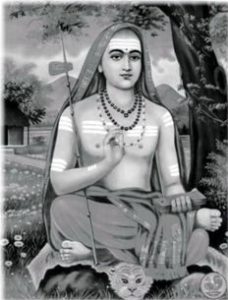 We all know that the shruti predominantly adopts the model of adhyAropa–apavAda (superimposition – sublation) in imparting the incommunicable Advaita message. There are other types of models and prakriyA-s also available in the scripture and tradition but they do not seem to be as popular. The adhyAropa–apavAda model superimposes an “imagined” or illusory creation on the really real Reality and as the student ingests the core Advaitic teaching, the superimposition is sublated. We find, however, that the shruti spends more time dealing with diverse aspects of the superimposed creation (birth, sustenance, death, action, fruits of action, rebirth etc.), the sublation being left to the ingenuity of the student as s/he reaches her/ his final understanding. One teacher estimates that Shankara in general devotes 90 percent of his time in most of his works on expiation of the Advaita doctrine and the attendant practices, leaving only a minor part on sublation and the outcome of the practices. This situation in some quarters has given rise to an insistence that the shruti teaches creation and that we have to take only the shruti vAkya-s and Shankara’s commentary on them as the pramANa (reference standard) for understanding the Advaita message forsaking other methods and vAkya-s in the scripture. Is that the intention of shruti? What is the final position of the shruti about creation from an Advaita perspective? Continue reading
We all know that the shruti predominantly adopts the model of adhyAropa–apavAda (superimposition – sublation) in imparting the incommunicable Advaita message. There are other types of models and prakriyA-s also available in the scripture and tradition but they do not seem to be as popular. The adhyAropa–apavAda model superimposes an “imagined” or illusory creation on the really real Reality and as the student ingests the core Advaitic teaching, the superimposition is sublated. We find, however, that the shruti spends more time dealing with diverse aspects of the superimposed creation (birth, sustenance, death, action, fruits of action, rebirth etc.), the sublation being left to the ingenuity of the student as s/he reaches her/ his final understanding. One teacher estimates that Shankara in general devotes 90 percent of his time in most of his works on expiation of the Advaita doctrine and the attendant practices, leaving only a minor part on sublation and the outcome of the practices. This situation in some quarters has given rise to an insistence that the shruti teaches creation and that we have to take only the shruti vAkya-s and Shankara’s commentary on them as the pramANa (reference standard) for understanding the Advaita message forsaking other methods and vAkya-s in the scripture. Is that the intention of shruti? What is the final position of the shruti about creation from an Advaita perspective? Continue reading
Tag Archives: apavada
Q. 393 – Idealism or Realism?
Q: Advaita often uses certain language and metaphors, and these can often come across as sort of a “subjective idealism plus”. Where subjective idealism argues that the “outside world” is a completely nonexistent illusion produced in a mind, Advaita sometimes seems to say yes, that’s true – only, behind that mind that imagines the world is consciousness witnessing the mind, which is “projected” onto consciousness by the mysterious maya. In other words, Berkeley was right, only he didn’t go far enough. This leaves Advaita sounding like total solipsism, blended with hardline idealism. Consciousness, some sort of unimaginable void incapable of anything, is having a mind and a world “imagined” onto it by maya, which despite the incapability of consciousness to do anything is still a “power” of that consciousness. (Of course, this is very much a conceptualization, taking these metaphors too literally and looking at these terms and concepts through a very Westernized lens. But this is often the way some teachings sound!)
But in addition to the talk of all things being total illusion, I will also hear that Advaita is realist – that the universe is not a hallucination; that it is, in one sense, “actually there”; and that it is in comparison to the changeless paramarthika viewpoint that vyavahara is “unreal”. This position makes much more sense to me than imagining the universe to be some sort of magic trick.
Now, I recognize that these explanations – both of them – are attempts to “point” at truth, and not a tidy description of truth itself. Ultimately, there is only brahman; there are no “illusory things” and no “real things”. But I’m far from truly grasping that yet, so I suppose my question is: which of these descriptions more accurately reflects the nature and relation of vyavahara and paramartha? Or are both illustrations only as useful as what they can communicate to a student? Or am I just getting way too caught up in concepts here? Continue reading
Vedanta the Solution – Part 19
VEDĀNTA the solution to our fundamental problem by D. Venugopal
Part 19 explains why a traditional teacher should be approached and briefly outlines the methods of teaching.
There is a complete Contents List, to which links are added as each new part appears.

